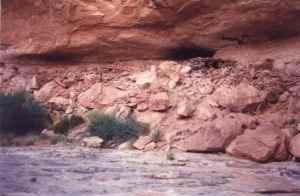
 |
I think the most awesome set of ruins I have found to date has to be the group of kivas shown here. The kiva is a partially subterranean religious center consisting of a sunken, circular pit, a fire pit, a ventilation shaft bringing air to the fire, an air deflector for the fire, a sipapu (a hole representing the place of emergence into this world), and usually small alcoves in the walls. The kiva is entered by a ladder from the roof. |
| Kivas are believed to have evolved from early pit houses and are found extensively among the Anasazi ruins. Kivas are still in use today by the Hopi and New Mexico pueblo Indians. The kiva religious ceremonies today are usually closely guarded secrets, known only to initiated members of the kiva society and entry by non-members is forbidden. It appears that the Anasazi typically burned or in other ways destroyed they kivas prior to abandonment, so the discovery of intact kivas is very unusual. | 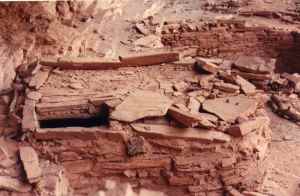 |
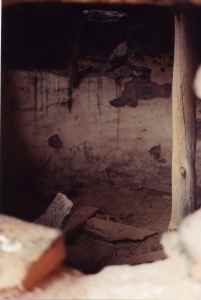

I reached this set of Kivas by driving to the end of a dirt road, then setting off cross-country across a mesa top for about a mile till I came to a canyon. After considerable searching I found a way down into the canyon and hiked several miles up canyon till I came to the point shown in the upper left picture. The tops of several kivas are visible along the ledge. Scrambling up, onto the ledge, I found a set of about 7 kivas, 3 of them completely intact. The best preserved kiva is shown in the picture in the upper right, with another roofless kiva visible behind it. This intact kiva looks like it could have been used yesterday (although it was probably abandoned around 1300 AD), and in fact looks to be in as good a condition as kivas currently in use on the Hopi mesas. Another two well preserved kivas are shown in the picture on the right, just behind the open kiva in the foreground. Looking into one of these kivas I was greeted with the scene on the right - plaster on the walls, roof supports in tact, smoke deflector, and the sipapu.
| Often at these remote ruins, one can find numerous artifacts (because the people that make the effort to visit these sites have enough respect to leave what they find for others to enjoy). This site was no exception. In addition to the mano and metate (for grinding corn) shown in the picture on the right, I found hundreds of pottery shards, a few arrow heads, and even bone needles. The picture also shows 700 year old corn cobs, preserved by the arid climate of the southwest. |  |
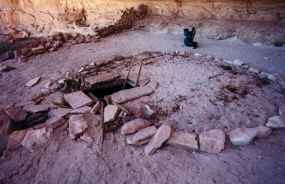
|
While the 7 kivas described above represent an astonshing collection of well preserved Anasazi ruins, the most perfect ruin I have ever found was the completely intact kiva shown here. While the 7 kivas are easily visible from the canyon bottom while walking in a remote and rugged canyon, the perfect kiva is hidden in an alcove high on a canyon wall, invisible from the bottom. Descending the ladder into the kiva reveals a kiva with alcoves intact, the sipapu, fire pit, air deflector, plastered walls, and nice clear air vent. |

|

|
| This perfectly preserved kiva and adjacent building (roof intact) were found in an alcove in a small side canyon. In addition to building and kiva, there were a number of petroglyphs, a rock with grooves worn from sharpening knives or scrapers, several rocks with rows of corn grinding pits, and a number of artifacts, including pottery shards, corn cobs, and rope. |
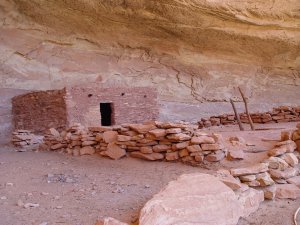
|
This kiva had the usual mano and metate for grinding corn, but in addition, there were several rocks with rows of grinding pits worn in them, and one rock with a row of grooves worn from sharpening knives.
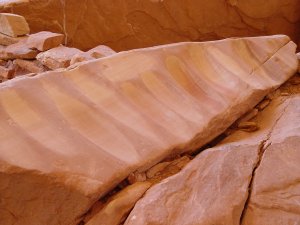
|
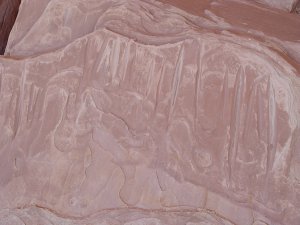
|
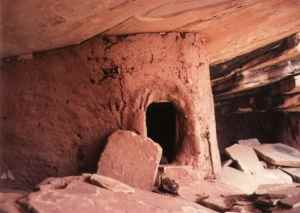 |
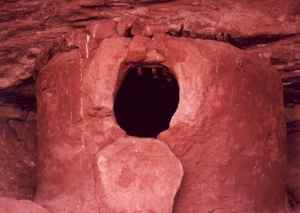 |
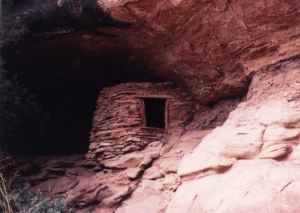 |
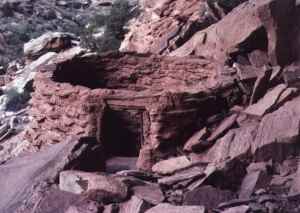 |
| As I understand it, stone granaries are thought to represent the last phase of Anasazi building. These three pictures show well preserved examples of stone graneries (I did chide my friend in the picture on the right for disturbing the door). | 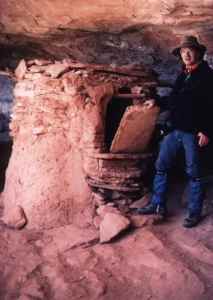 |
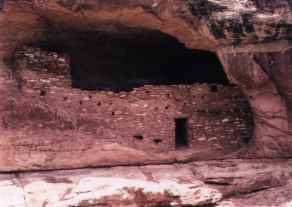 |
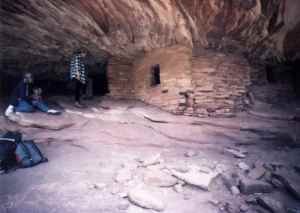 |
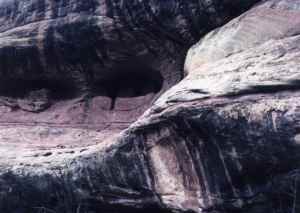 |
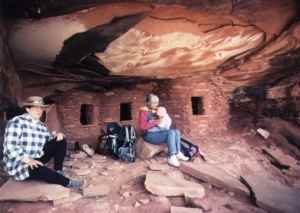 |
| This interesting ruin, known as the "Jail House Ruin" is set high on an exposed ledge, not in a sheltered alcove. It is a split level ruin. I was able to find a path up to the main ledge, and then clamber up to the first level ruin, but getting to the more extensive, upper level was beyond my abilities. This ruin exhibited both stone work and mud covered wooden frame structures, the latter mostly inside the outer stone work. Also note the two large white "faces" above the upper level. These were clearly visible from far out in the main canyon. | 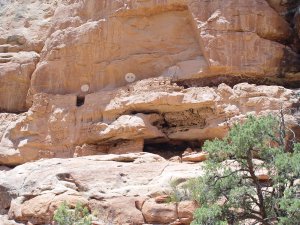 |
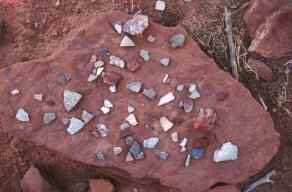
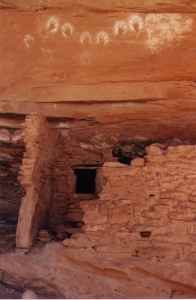 One of the things that makes many of these sites so fascinating is that they are
not mere mute stone, but instead include artifacts and other tokens left by their
former inhabitants. The picture at the left shows a typical example of pottery
shards found and left by former visitors. Many of the ruins include "hand prints"
on the ceiling above the ruins, as shown on the right. Are these simply the mark
of the builder? Children playing? Symbols of protection to ward off evil? One can
also see individual finger prints in the mud mortar between rock layers, where
someone, 700 years ago pressed their finger against the mud, pushing it into place
while building their granary or house. The pictures below show more pottery shards,
and a pile of 700 year old corn cobs.
One of the things that makes many of these sites so fascinating is that they are
not mere mute stone, but instead include artifacts and other tokens left by their
former inhabitants. The picture at the left shows a typical example of pottery
shards found and left by former visitors. Many of the ruins include "hand prints"
on the ceiling above the ruins, as shown on the right. Are these simply the mark
of the builder? Children playing? Symbols of protection to ward off evil? One can
also see individual finger prints in the mud mortar between rock layers, where
someone, 700 years ago pressed their finger against the mud, pushing it into place
while building their granary or house. The pictures below show more pottery shards,
and a pile of 700 year old corn cobs.
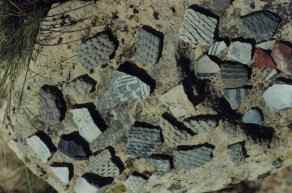 |
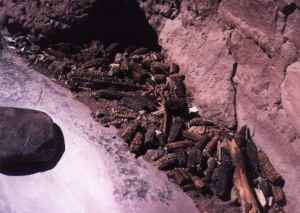 |

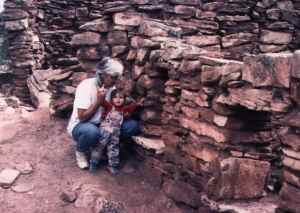
Not all of the Anazasi ruins are located in canyons or in alcoves high on cliff walls. Some of them are built in broad valleys and resemble apartment buildings. One area I explored with my family is shown in these pictures. We were on a dirt road running through a wide, shallow valley (ideal for crops). In the trees at the edge of the valley we noticed several structures, ranging from the apartment like building shown on the left, to the tower shown on the right. While these structures were located within sight of each other, they were not adjacent and the relationship is a mystery. Several other buildings were located in the same valley.
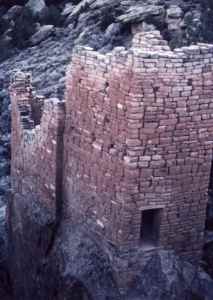 |
On another trip to an area not too far from the valley, I found the building shown here, perched high on the rock. This one reminds me of a Scottish castle, but you have to mind that first step going out the door! |
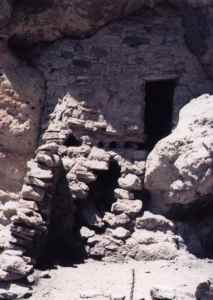
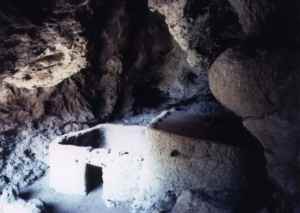
Located to the south and west of the four corners stronghold of the Anasazi, the Salado Indians also built impressive stone buildings. On one canyon hike (by myself in southern Arizona in August) I looked up at a cliff and saw what looked like a small cliff dwelling. Thinking, "Gee, if I fall trying to get up to that, no one is likely to find me for several months, when it is a bit cooler", I proceeded to throw caution to the wind and scramble up. What I thought was a small structure in a small alcove, was actually a wall at the edge of a large cave with several buildings inside! One building consisted of a walled up alcove (shown on the left), while the picture on the right shows the free standing buildings inside the cave. Note the completely intact roof on the larger building!
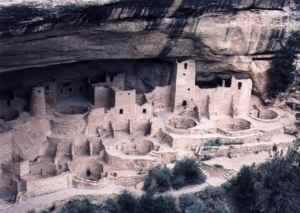 |
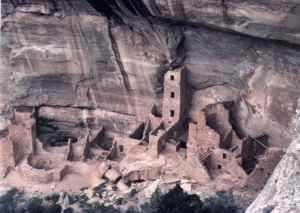 |
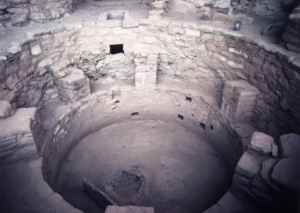 |
A Cliff Palace kiva is shown here. Unlike the kivas shown at the top of the page, this one has been extensively excavated, cleaned, and reconstructed. You can see the fire pit and the air deflector. Another nearby National Monument with a very impressive kiva is Aztec National Monument. A great kiva, somewhat larger than the one shown here, has been completely reconstructed, roof and all. It contains a number of interesting features not found in the smaller, standard kivas, and may have served as a more public center of religious activities than the more secretive standard kivas. |
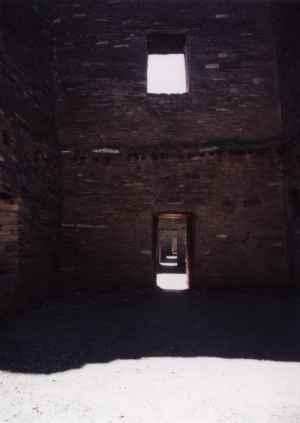
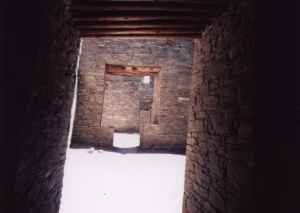
My favorite Anasazi park is Chaco Canyon. Chaco is believed to have been the center of the Anasazi culture and represents both the peak of their building expression, as well as several interesting mysteries. Chaco contains several large building complexes, the most famous of which are Pueblo Bonito and Chetro Ketl. Pueblo Bonito contains over 600 rooms and along one wall reached five stories in height. Archeologists are unsure how the Chaco complex was utilized. They do not believe the immediate vicinity could have supported a population which would fill all of the large complexes located here, so they have speculated that perhaps Chaco was only used for special ceremonies. But it represents an awfully large expenditure of energy, especially if the population did not live in the immediate vicinity. Chaco was also the center of an extensive road system consisting of well graded, wide roads. Interestingly, these roads were much wider and better maintained than necessary for simple foot travel, but the Anasazi had neither horse nor wheel. In any event, the size of the Chaco complex, and the system of roads, clearly indicates that Chaco was the center of a major and sophisticated civilization.
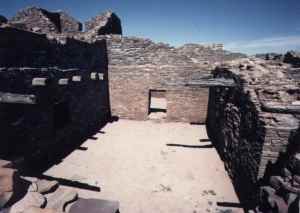
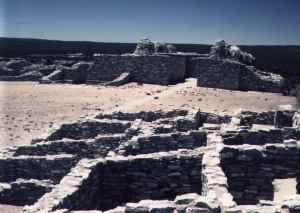 |
 |
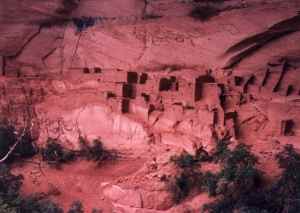 |
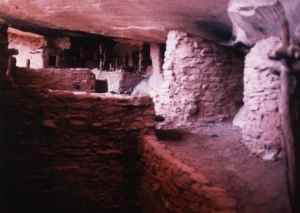 |